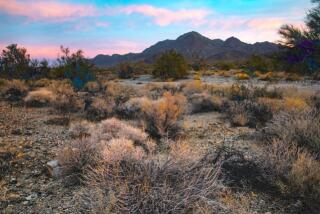The Administration Can’t See the Forest for the Sequoias
- Share via
In the spring of 2000, then-President Bill Clinton issued a proclamation establishing the Giant Sequoia National Monument east of Bakersfield, ensuring that the giant sequoia groves and their surrounding ecosystems would be forever protected, or so we thought.
This month, the Bush administration announced its draft management plan for the 329,000-acre monument, which proposes a commercial logging program that includes patch clear cuts within the sequoia groves and large-scale removal of big, green trees. Even century-old giant sequoias would be logged.
That the Bush administration would target such a revered refuge for logging raises a serious question: If the Giant Sequoia National Monument isn’t safe under this administration, what is?
Though shocking, the move comes as little surprise, given that the sequoia monument is still managed by the U.S. Forest Service, which, in turn, is overseen by a former timber industry lobbyist, Bush appointee Mark Rey.
The plan cavalierly ignores the fact that the monument proclamation was clearly intended to prevent continued logging and designed to ensure far greater protection than the area previously had as a national forest.
Instead, the Bush administration’s proposal turns this goal on its head.
What’s even more disturbing is that the plan claims such logging of large trees is necessary to prevent severe forest fires.
The federal government’s own scientists have consistently found that removal of large trees increases severe fire risk by removing the most fire-resistant elements -- big trees -- from the forest and by reducing the cooling shade of the forest canopy.
The logging of mature trees also increases sun exposure, causing more rapid growth of highly flammable brush within a few years.
Indeed, the comprehensive Sierra Nevada Ecosystem Report, which was produced by university and Forest Service scientists, concluded that “timber harvest, through its effects on forest structure, local microclimate and fuel accumulation, has increased fire severity more than any other recent human activity.”
The report recommended thinning of undergrowth and prescribed burning as appropriate fire management tools. It strongly opposed the removal of mature trees.
The Forest Service’s own National Fire Plan, which again was developed by government scientists, warned that the Forest Service “should not rely on commercial logging or new road building to reduce fire risks” because the “removal of large, merchantable trees from forests does not reduce fire risk and may, in fact, increase such risk.”
The Bush administration doesn’t appear to care what the nation’s top scientists -- even the government’s own researchers -- are saying.
For this administration, it’s all about pleasing big timber industry campaign contributors, and logging corporations have no interest in underbrush.
The timber industry wants economically valuable big trees, and lots of them.
The Giant Sequoia National Monument was established for the protection of the sequoia ecosystem and the species it supports, including the California spotted owl and the mink-like Pacific fisher.
The fisher is nearly extinct in the Sierra, in large part because of habitat degradation from logging.
Bush’s new logging plan may well drive the remaining fisher population to extinction in the Sierra Nevada range.
This plan to “save” the Giant Sequoia National Monument by allowing logging corporations to clear-cut within sequoia groves and remove big trees is more than a little disingenuous.
It is a shameless political move loaded with enough hypocrisy and cynicism to flatten a forest.
More to Read
Sign up for Essential California
The most important California stories and recommendations in your inbox every morning.
You may occasionally receive promotional content from the Los Angeles Times.










